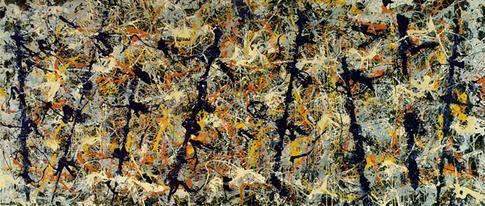Year 1952 (1952) Dimensions 2.1 m x 4.86 m Media Oil paint | Artist Jackson Pollock Created 1952 Genre Abstract art | |
 | ||
Type Enamel and aluminium paint with glass on canvas Locations National Portrait Gallery, National Gallery of Australia Similar Jackson Pollock artwork, Oil paintings, Abstract art | ||
Jackson pollock blue poles number 11 1952 1952
Number 11, 1952, also known as Blue Poles, is an abstract expressionist painting and one of the most famous works by American artist Jackson Pollock. It was purchased amid controversy by the National Gallery of Australia in 1973 and today remains one of the gallery's major paintings.
Contents
- Jackson pollock blue poles number 11 1952 1952
- Title
- 1973 National Gallery of Australia purchase
- 19981999 Museum of Modern Art retrospective
- 20162017 Royal Academy of Arts Abstract Expressionism exhibition
- Legacy
- References
Title
At the time of the painting's creation, Pollock preferred not to assign names to his works, but rather numbers; hence, the original title of the painting was simply "Number 11"' or "No. 11" for the year 1952. In 1954, the new title Blue Poles was first seen at an exhibition at the Sidney Janis Gallery and reportedly originated from Pollock himself.
According to art historian Dennis Phillips, the specific rather than ambiguous title "limits our field of comprehension and does the painting a singular disservice. Because we look for the poles and miss much of the rest, the name is simply too distracting."
1973: National Gallery of Australia purchase
The National Gallery of Australia purchased Blue Poles in 1973 for A$1.3 million. The gallery's director at the time, James Mollison, was not able to authorise purchases over $1 million, so the acquisition was approved by Prime Minister Gough Whitlam.
The purchase elicited a great deal of public discussion; according to art historian Patrick McCaughey, "never had such a picture moved and disturbed the Australian public". The debate centred on the painting's record selling price, at the time a world record for a contemporary American painting, as well as the perceived financial ineptitude of Whitlam's Labor Party government and debate over the relative value of abstract art. In the conservative climate of the time, the purchase created a political and media scandal.
1998–1999: Museum of Modern Art retrospective
In 1998, Blue Poles left Australia for the first time since its purchase for inclusion in a Pollock retrospective at the Museum of Modern Art in New York which ran from 1 November 1998 to 2 February 1999. The painting was the signature work of the exhibition, and as described in a review, it "dominated" the last gallery of the show, ending it "not with a whimper, but a bang".
2016–2017: Royal Academy of Arts Abstract Expressionism exhibition
While rarely loaned, the work will be displayed as part of the Royal Academy's Abstract Expressionism exhibition which runs from 24 September 2016 to 2 January 2017 in London.
Legacy
The painting has become one of the most popular exhibits in the gallery, for both its value as a major work of 1950s abstract expressionism, and its significance in Australian politics and history. Estimates of the painting's present value vary widely, from $20 million to $100 million, but its increased value has at least shown it to have been a worthwhile purchase from a financial point of view.
